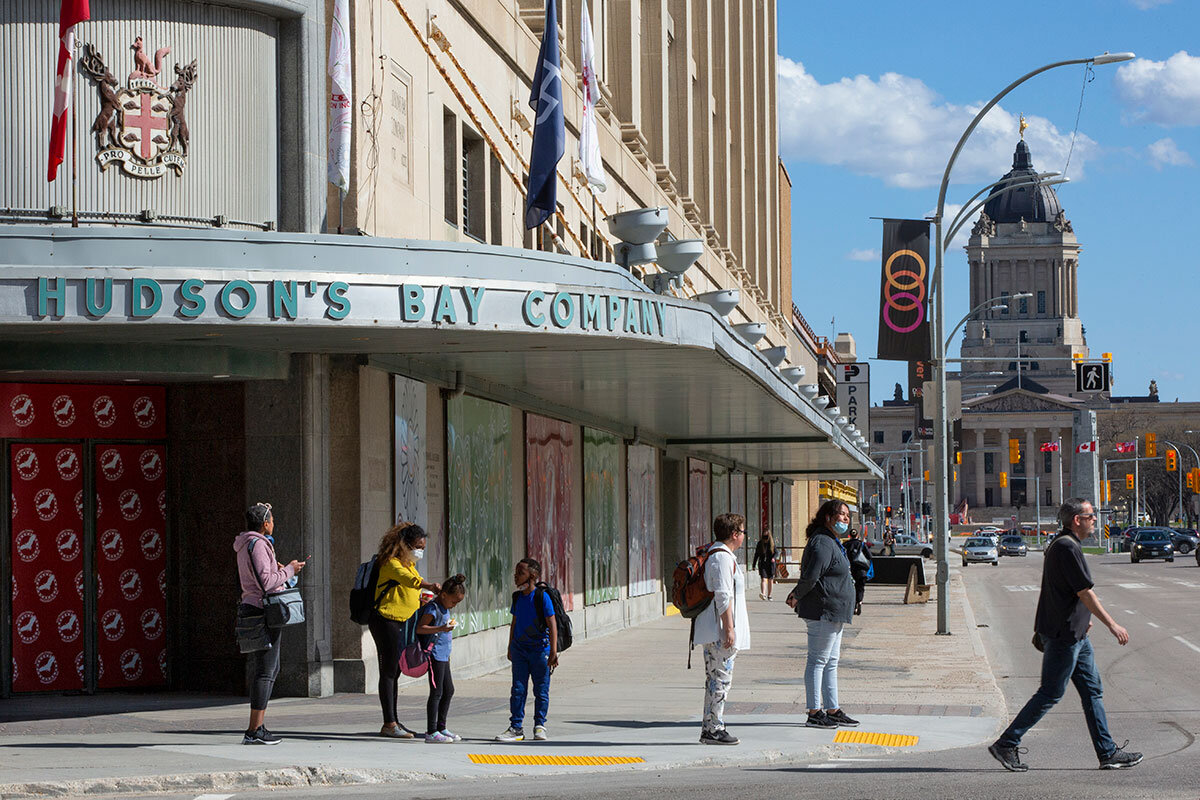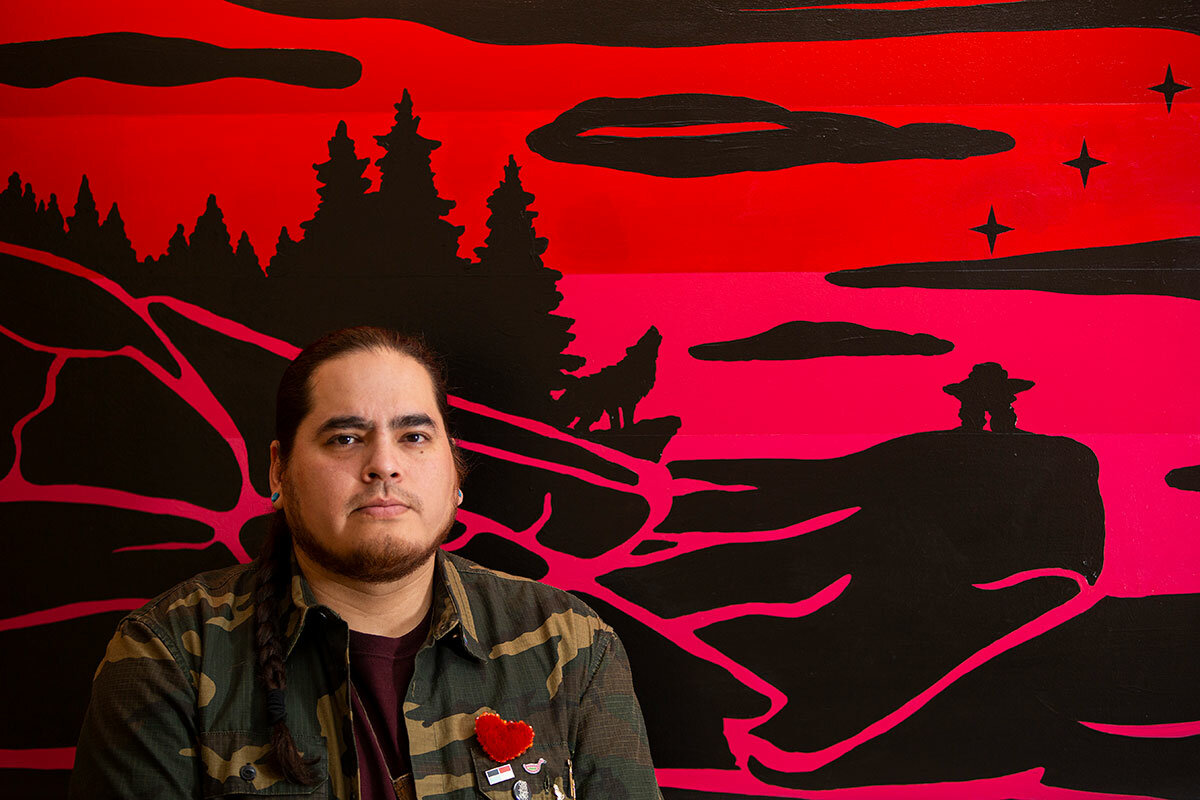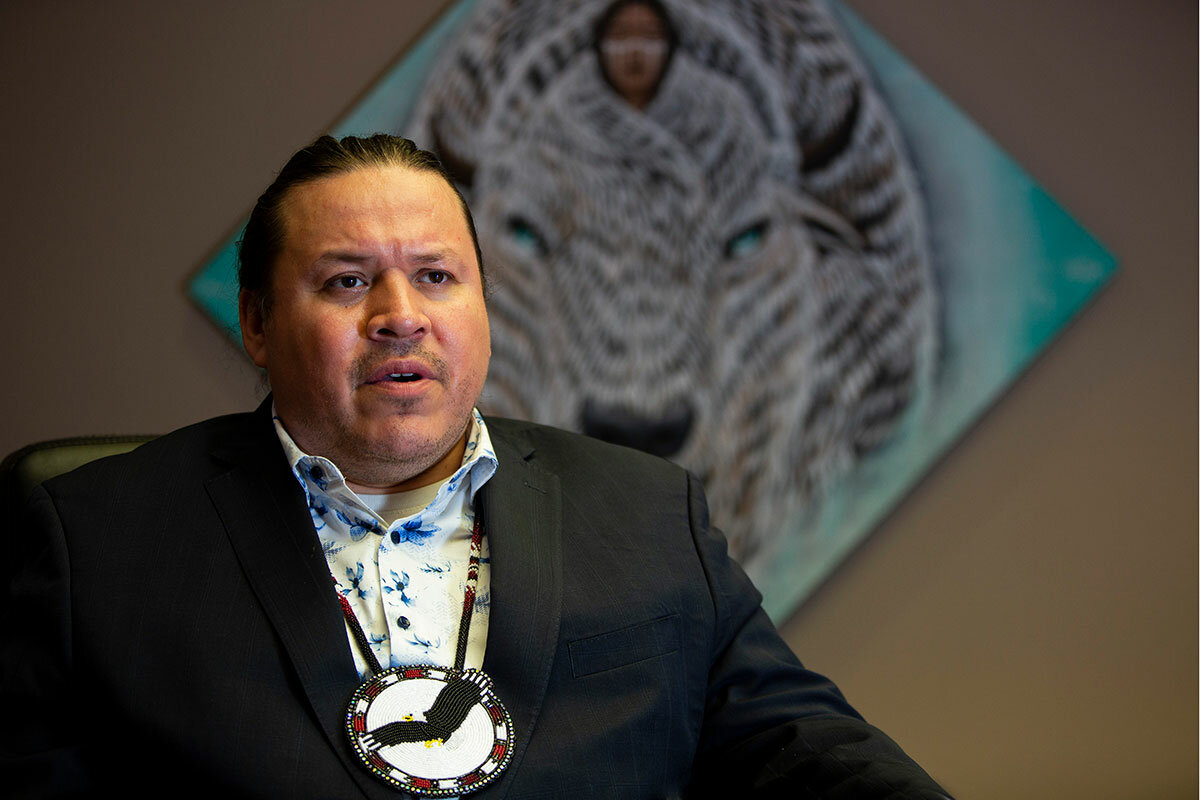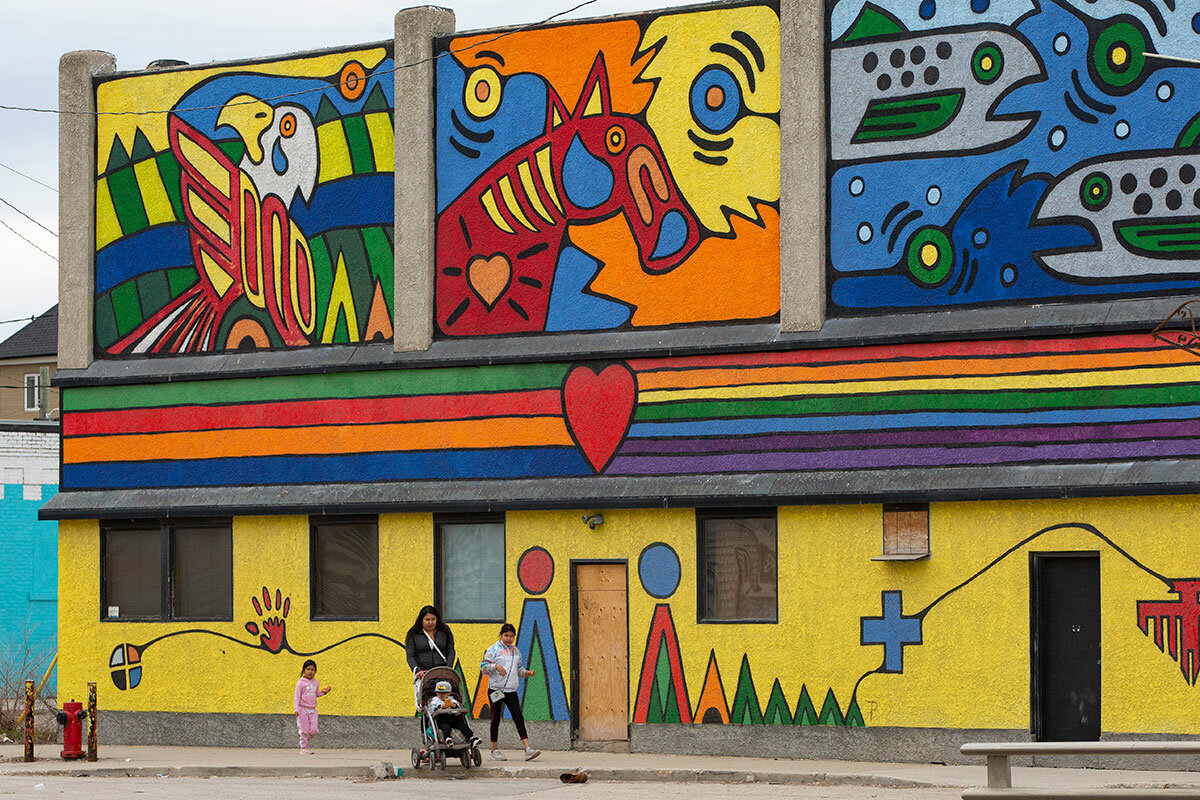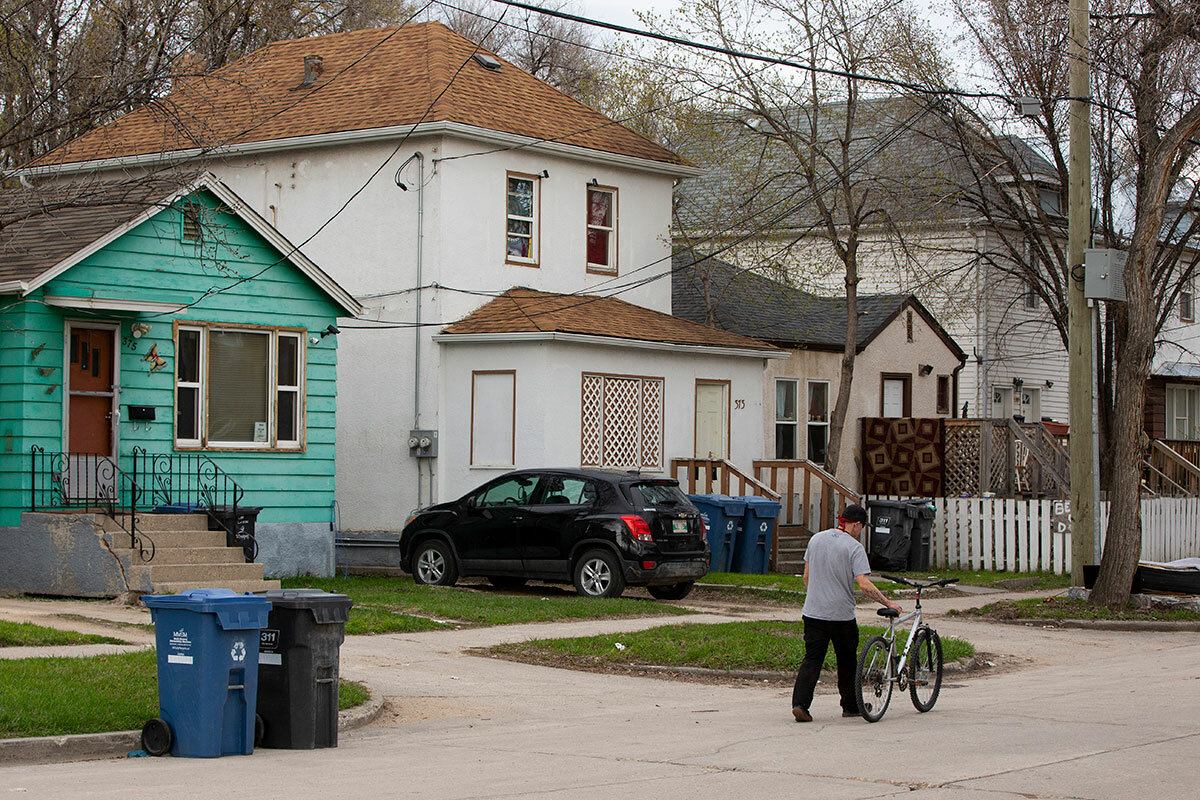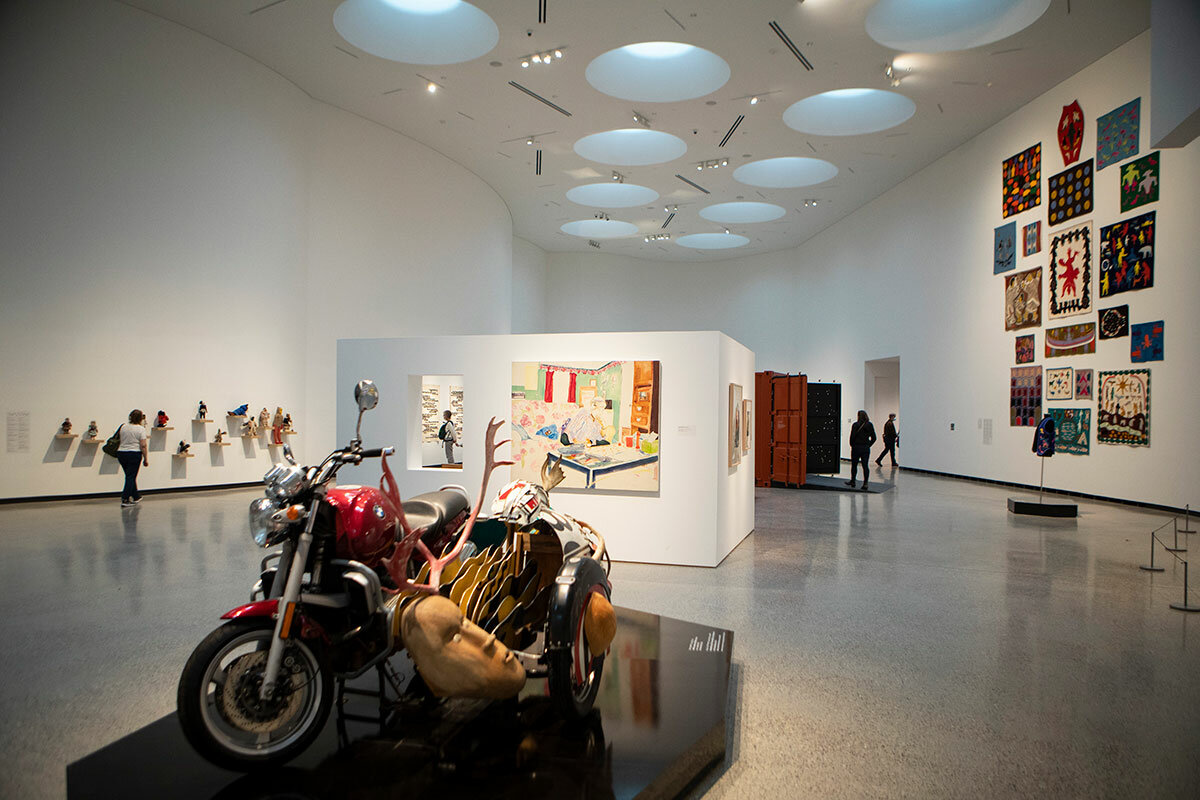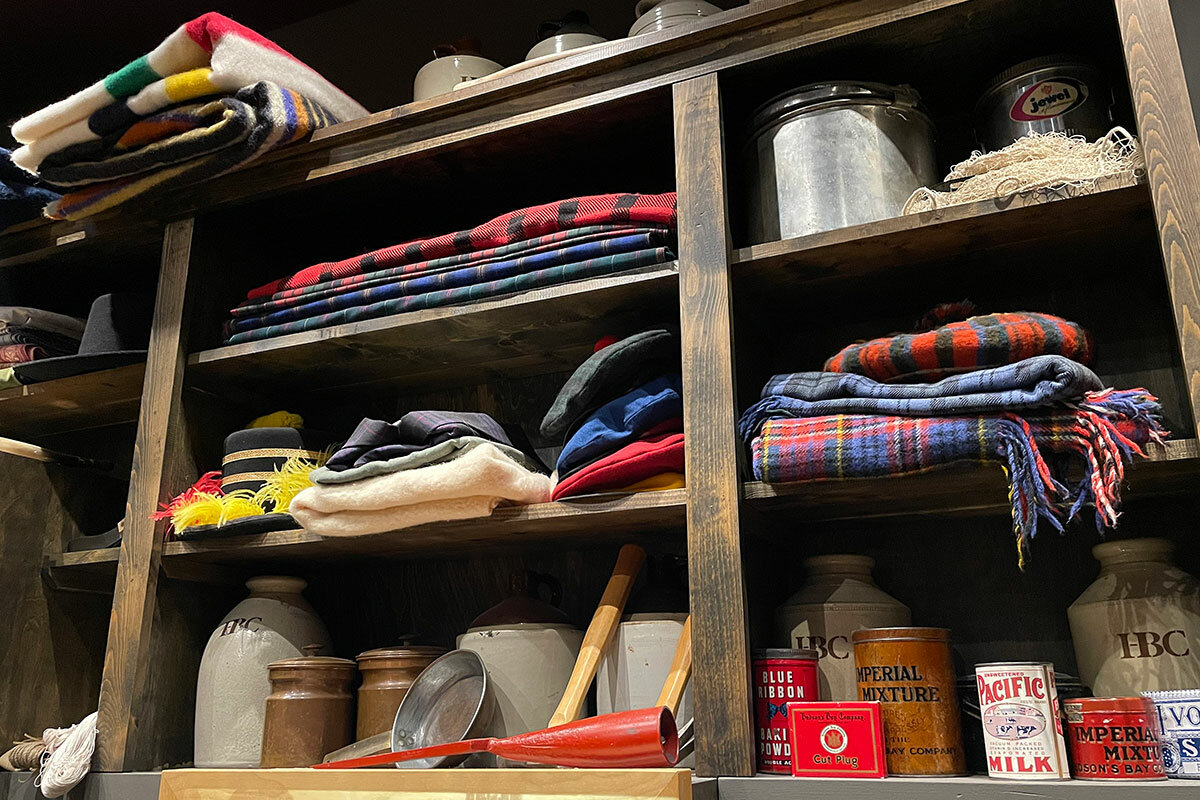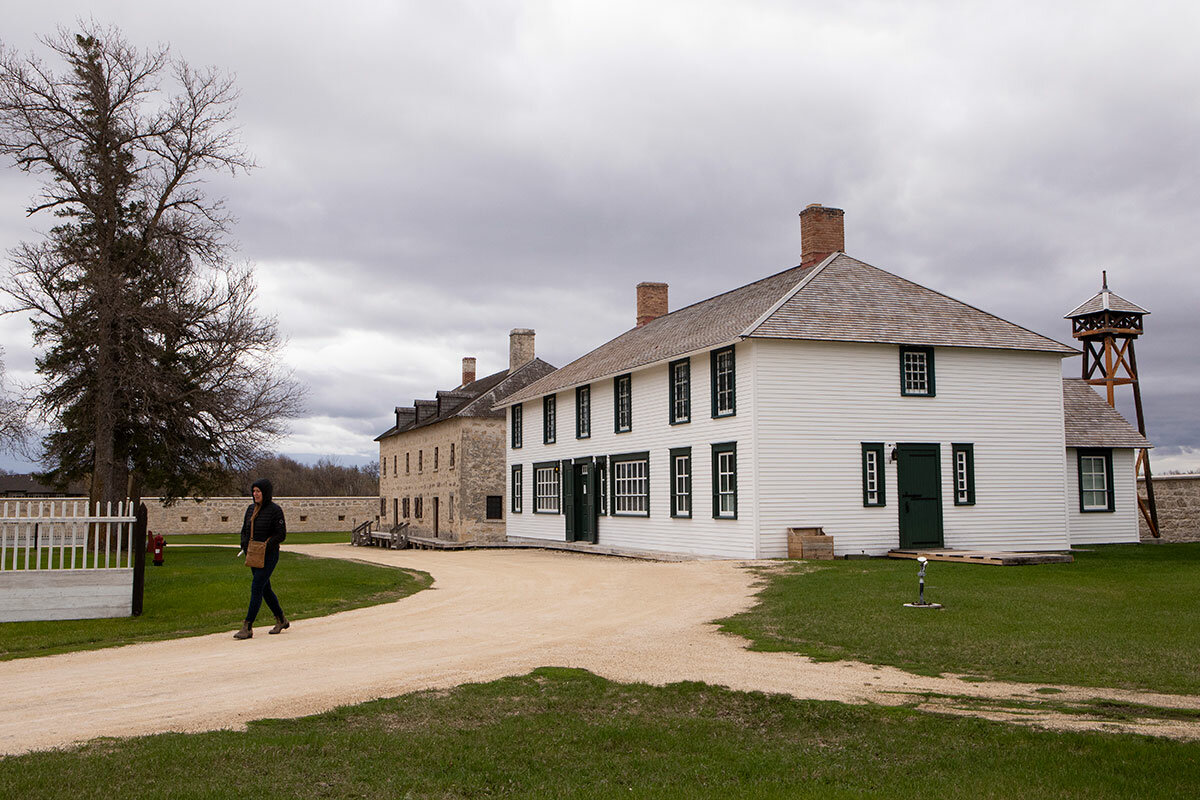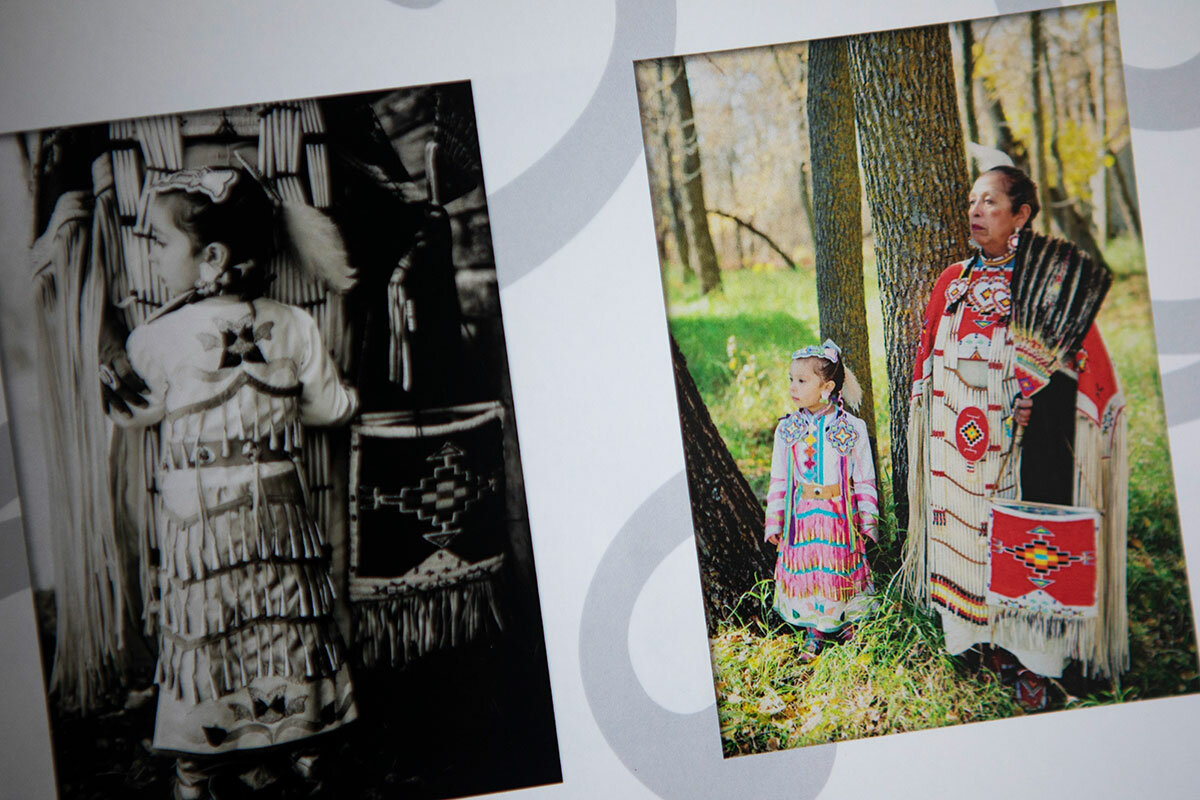In Winnipeg, a vacant store is a symbol of Indigenous renewal
Loading...
| Winnipeg, Manitoba
After the Hudson’s Bay Co. department store shuttered its hulking, 650,000-plus-square-foot building in downtown Winnipeg��in 2020, Peatr Thomas was asked to replicate one of his murals in the empty windows.
The Inninew and Anishnaabe artist at first hesitated. If any entity casts a colonial shadow in Canada, it is the Hudson’s Bay Co.
Established in 1670 by the king of England, the HBC existed for centuries as a fur trading enterprise that upended the lives of First Nations as it aggressively expanded into what would later become Canada. Mr. Thomas didn’t want to be affiliated.
Why We Wrote This
The Hudson’s Bay Co. was a key colonial power – and disrupter of Indigenous lives – in Canada. Now, First Nations plan to turn its flagship Winnipeg store into a force for renewal.
At the same time, the flagship store in Winnipeg looms large - physically and in historical relevance. Mr. Thomas saw an opportunity to share his vision of a “new future,” he says, “built on truth.”
Today his vibrant mural, “Aski Pimachi Iwew,” reflects back the story of the earth’s renewal. Animals painted in black, upon a red background representing dawn, depict the seven ancestor teachings of “Turtle Island,” what many Indigenous people call North America: love, wisdom, respect, courage, honesty, humility, and truth.
It’s accompanied by text written by his mother, a residential school survivor:
A new sunrise with the new moon.
After a time of change and awakening.
Turtle Island is new once again, built on truth in the sacred seven ancestor teachings.
Ancient knowledge once lost, is taught to us again by Mother Earth in all that she offers.
His mural would be a taste of what’s to come to downtown Winnipeg. Since April, colorful flags and banners have enlivened the building’s drab neoclassical facade, installed by the Southern Chiefs’ Organization (SCO), which represents 34 First Nations groups in southern Manitoba.
This spring HBC, now a holding company that owns businesses and investments including Saks Fifth Avenue, transferred the building to the SCO. The Indigenous leaders plan to turn it into a multifaceted facility centered around low-income housing for the urban Indigenous community, as well as restaurants, pop-up stores, and space for artists. It will also become the new seat of SCO governance.
At a time when Canada says that Reconciliation with Indigenous peoples is a driving goal at the highest levels of government, the transfer of a colonial icon to Indigenous leaders resonates with symbolism��– and is seen as a tangible sign of renewal. Its working title in Anishinaabemowin is Wehwehneh Bahgahkinahgohn, or “It is visible.”
“I think it was important for us to let it be known that this is the change that’s coming,” says Jerry Daniels, the grand chief of the SCO, whose offices are currently based on the industrial outskirts of Winnipeg near the airport. “This is what Reconciliation is. ... It’s a great example of what’s possible.”
“It was uniting all of us”
HBC is Canada’s oldest company. It was chartered in 1670 by King Charles II, after two fur traders convinced him that a base on the shores of the Hudson Bay would provide direct access to the beaver pelts so popular in Europe at the time.
HBC would come to rule over trapping grounds that represent a third of Canada today. And in its pursuit it would drive settlement across the continent, acting as a de facto government and disrupting communities that had been self-sustaining with their own sophisticated trade networks and diplomatic ties to one another. In the era of the English East India Co. and Dutch East India Co., the colonialists didn’t question their moral authority to do so.
So when the building at Portage Avenue was transferred to Indigenous leaders 352 years later this April, it was so rich in iconography that it drew leaders from all levels of government, including Canadian Prime Minister Justin Trudeau, who called it an act of “reclamation.”
In an elaborate ceremony, Grand Chief Daniels, in a beaded headdress, transferred two beaver pelts and two elk hides, the traditional “rent” under the original charter, to the governor of HBC, New York business executive Richard Baker.
Sophia Smoke was invited there as the oral historian. She’s an eloquent 14-year-old from Dakota Plains Wahpeton First Nation in Manitoba whose ceremonial role was a nod to an Indigenous way of history.
She addressed the crowd in the Dakota language, which her grandmother taught her, before continuing in English. “Today there is no mistaking, we are changing the course of history for good,” she told the crowd.
A few weeks later, from her living room in Portage La Prairie, an hour west of Winnipeg, she reflects on what it meant to her. “It was uniting all of us,” she says.
And that felt transformative, adds her mother, Joan Smoke. “A long time ago when agreements were made, everything from treaties to the ceding of different parcels of land, it was done in the language of the colonizers, and the spirit and the intent wasn’t understood,” says Ms. Smoke, a school principal. “Being present at [the HBC] ceremonies, I felt like the spirit and the intent of what we were doing was understood by both parties.”
The geographic heart of Canada
At the confluence of the Red and Assiniboine rivers,��Winnipeg was central to HBC operations, and that had a profound effect on the province’s course of history. The fur trade gave rise to the Métis Nation��– the sons and daughters of Europeans and Indigenous women whose marriages were crucial to the success of the trade. HBC spurred the settlement of the Red River Colony that would later become Winnipeg. Always a crossroads, Winnipeg became a major transport and grain hub at the geographic heart of Canada.��
Today, Winnipeg counts the largest urban Indigenous population in Canada with over 92,000 (in a population of 750,000). It has led to a vibrant Indigenous social and cultural scene that is increasingly present on the cityscape. But the economic reality of Indigenous peoples, dispossessed from their lands, also comes into stark view here.
According to the latest census figures, 31% of Indigenous people in Winnipeg live below the low-income threshold, compared with 13% of the non-Indigenous population. Homelessness is a major problem for the city, and 66% of those in emergency shelters, transitional housing, and safe spaces identify as Indigenous. Child poverty is the highest of any province.
The SCO project is intended to help correct these imbalances. The Manitoba government is providing $35 million to help redevelop the HBC site; the federal government has promised another $65 million. A centerpiece of the project is the 300 housing units for low-income residents.
Mr. Daniels, from Long Plain First Nation, says he experienced much turbulence growing up, part of the child welfare system for a while. He says providing stable housing will have a ripple effect on the community that’s suffered poverty and intergenerational trauma, especially from the residential schooling system.
“Families are built on the stability of their grandparents and their great-grandparents who were able to provide the knowledge and the love and support to engage in different areas,” he says. “We didn’t have that opportunity. We didn’t have that luxury. Ours was filled with abuse. It was filled with addictions. It was filled with exclusion and racism.”
That shows up today in the huge gaps in health care, education, labor participation, and housing. “We want to acknowledge that and try to create change as quick as we can,” he says. Mr. Daniels says they hope to break ground in mid-August.
“Opportunities to restructure ourselves”
Wehwehneh Bahgahkinahgohn is meant to be a vibrant hub, with two restaurants and community space. It will showcase Indigenous art and culture and include a museum that tells the role that Indigenous people played in the founding of HBC from their perspective.
The building reinforces a transformation already underway in Winnipeg. There is Qaumajuq, billed as the largest Inuit art center in the world, that opened last year. There is the Canadian Museum for Human Rights, which dedicates a significant portion of its permanent display to the truth about Canada’s violent assimilationist policies. Indigenous murals, sculpture, and gardens color the cityscape.
Now the SCO project will contribute to Winnipeg by revitalizing a part of the city that had been neglected, says Amelia Fay, curator of the HBC collection at the Manitoba Museum. As downtown retail declined through the decades, the HBC lost vitality. But it’s so big��– it was the largest reinforced concrete structure in Canada when it was constructed in 1926��– that it left a vacuum in the heart of the city. “HBC held on to their retail involvement there probably far longer than they should have, purely based on the connection to that building,” she says.
The new project could become a model for other Canadian cities and landmarks, says Lloyd Axworthy, a former Canadian foreign minister and former president of the University of Winnipeg who is an adviser on this project.
“This is an act of restoration. It was a long time coming, but was done in a very cooperative way, and to have this initiated by a First Nations group, by the Southern Chiefs’ Organization, is an incredible statement of how history now can be restored or returned,” he says. “This project dispels the idea of Native people being dependent on welfare and all those kinds of stereotypes. No, they are entrepreneurs, they are activists doing important things, and they can manage a big project.”
Stephen Bown, author of the book “The Company,” which tells the story of the first 200 years of HBC, says the Winnipeg project in some ways takes history full circle. “The amount of Indigenous involvement in that business often goes unrecognized,” he says.
While run from London, HBC on the ground depended on the knowledge, savvy, and goodwill of the Indigenous inhabitants. “That began right from the very, very beginning. And those cultural links are what enabled the company to thrive and survive. The company was essentially almost a subbranch of Indigenous cultures,” he says. “The symbolic significance could be that the company is returning maybe in one sense to its roots as an Indigenous-run thing.”
Mr. Thomas, the muralist, says that if done right, the project will be an important space for the Indigenous population. “For the longest time, we as Indigenous people were so oppressed and silenced. Now we are having these opportunities to restructure ourselves as peoples and our culture,” he says, “by just having the same chance at life that any settler has had.”
That’s not to say he’s not still skeptical of HBC motives. While the company has painted the transfer as a commitment to Reconciliation, the building is so old, Mr. Thomas explains, that its value was assessed at $0. By handing it over, they solved a problem for themselves first and foremost, he suggests.��
He has never been shy about voicing criticism of the colonial company. The first version of his mural is on the walls of the Qaumajuq cafe. The Winnipeg Art Gallery later asked him to replicate it in the HBC. He designed it digitally and was able to stretch it to fit the window’s dimensions.
It’s the exact same version��– except for the patterns on the turtle shell. On the HBC rendering, Mr. Thomas designed the scutes (scales) in black to spell the words, “land back.”
Sophia Smoke says that the creation of “Indigenous spaces and places in the middle of Winnipeg” is not to be underestimated for Indigenous youths. “My friends and I are always talking about ‘land back,’ ‘land back.’ Now we’re going to ‘land back’ this giant, beautiful building. It’s happening close to home. It’s no longer a far-off fairy tale.”
She is already a youth activist. She is a jingle dress dancer, an Indigenous practice she has been learning from her grandmother since age 3. While her peers spend their summers at camp, she spends it with her family on the “powwow” trail, dancing across western Canada. She spends Friday nights learning the Dakota language from her grandmother.
Her mother struggled to assert that strong sense of identity when she was growing up, leaving her reserve for high school and later attending university. “You want to defend your history and you want to defend your community and stand up for yourself, but you never quite have the confidence,” her mother says. “So when I see my kid being unafraid and unabashedly Indigenous, it makes me really proud.”



